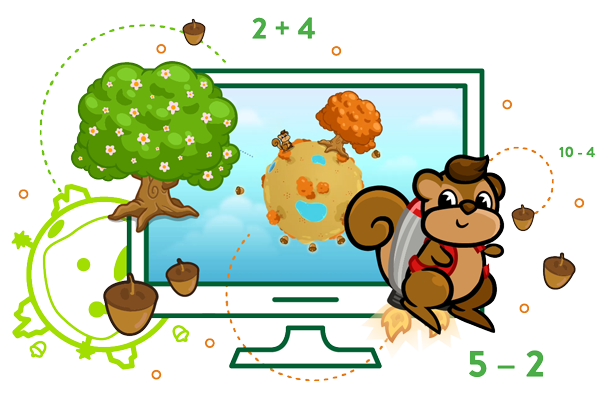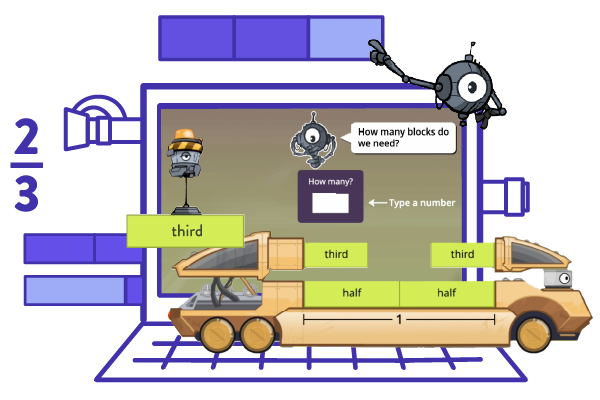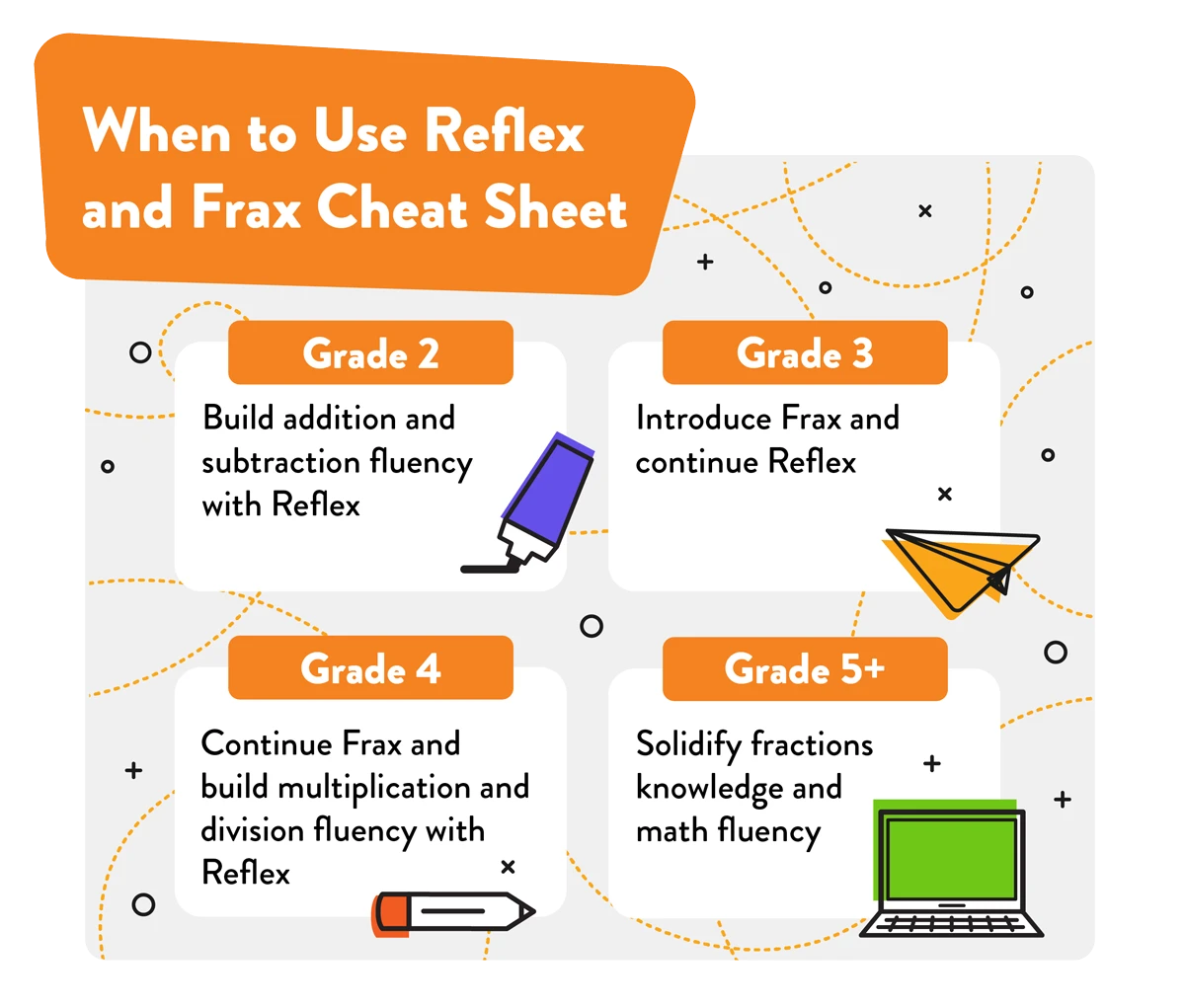Optimizing Math Instruction: When to Use Reflex and Frax

The school year is packed to the brim, and it’s safe to say teachers are experts at unpacking. They take complex curricula, scope and sequences, grade-level standards, textbooks, and instructional guides from their school or district to map out what students need to learn. For every month, week, and day of the school year, teachers must always be conscious of what they taught before, what’s coming up next, and what they’re teaching today—all in addition to the 28 other things on their to-do list for any given hour!
Time is the most valuable asset in the classroom. Teachers want to make sure that whatever they use to support instruction (whether paper or digital) is both effective and fun.
ExploreLearning has two adaptive and research-based elementary math solutions: Reflex for math fact fluency and Frax for creating strong fractions foundations. When is the best time to use these math learning tools to amplify student understanding and optimize math instruction? Read on to find out.
Overview of Reflex

Reflex is the most effective math fact fluency solution available. Using research-driven instruction, Reflex helps students master math facts to free up critical working memory space for advanced problem-solving.
As students progress in Reflex games, the system continuously monitors students’ performance and adjusts the difficulty of fact retrieval, providing an optimal level of challenge within the limits of their current abilities to develop math fluency. Reflex is recommended for grades 2 and up.
Overview of Frax

Frax uses the latest evidence-based research and instructional methods to create a better way to learn fractions.
When students begin Frax, they complete space-themed missions grouped by Sectors on the Frax Galaxy Map. Frax missions are structured as game-based challenges, allowing students to learn by doing as they progress through carefully scaffolded instruction. Frax is recommended for grades 3 and up.
Best practices for using Reflex and Frax
When is the best time to use Reflex and Frax in the elementary school years? Reflex should be primarily used in grades 2-4 and Frax in grades 3-5. Teachers should prioritize Frax before starting a fractions unit. Teachers should devote any available time (before or after completing the recommended Frax work) to Reflex until students have reached a high level of fluency.
The ExploreLearning team does not recommend simultaneous heavy usage of Reflex and Frax. The most impactful results come from fidelity usage dedicated to each product at the proper time.
Grade 2: Build addition and subtraction fluency
In grade 2, students should begin building automaticity with addition and subtraction facts (0-10) using Reflex.
Before developing automaticity with addition facts, students should acquire basic connections between addition, cardinality, and counting. Teachers can use the Reflex Readiness Quiz and other pre-Reflex recommendations to ensure readiness. More resources are available in the Reflex Educator Resource Hub.
Grade 3: Introduce Frax and continue Reflex
In grade 3, students should continue addition and subtraction work in Reflex as needed.
Upon completion of addition and subtraction, teachers should switch students to Frax. Students should complete Frax Sector 1 (27 missions) to develop a conceptual understanding of fractions. For optimal outcomes, teachers should complete Frax before teaching fractions to propel learning forward when students begin the unit.
Students who complete Frax Sector 1 can transition to Reflex to practice multiplication.
When time allows, students can continue practicing their fractions skills in the Frax Sector Review Room. This space provides mixed practice in an arcade-like environment. By answering questions correctly, students earn additional tokens to customize their space cabin or Happy Acres Farm. This option is a fun and effective way to review for assessments and end-of-year testing!
Grade 4: Frax Sector 2 and Reflex multiplication and division
In grade 4, the goal is to complete Frax Sector 2 (30 missions). In Sector 2, students explore how to use fractions to build on the conceptual understanding and fractions number sense they developed in Sector 1. Since students practice foundational skills with each Frax mission, they must complete Sectors 1 and 2 sequentially for fractions success.
Grade 4 students who have not yet completed Sector 1 should do so. Even if these students do not complete Sector 2 before the class begins its fractions unit, completing Sector 1 will ensure that all students come into fourth-grade fractions instruction with the knowledge and skills needed to succeed.
Research shows that grade 4 students who complete Sector 1 are much more likely to reach their growth goals and achieve grade-level skills than those who don’t. This means that even those students who are only able to complete Sector 1 before beginning their 4th-grade fractions unit are still better able to learn their grade-level content than students who didn't. Of course, completing the Sector 2 content provides even more foundational skills and understandings for 4th-grade fractions content.
When time is available during periods not devoted to Frax, students should complete Reflex multiplication and division practice.
Grade 5+: Solidify fractions knowledge and math fluency
In grade 5, all students should complete Frax Sectors 1 and 2 if they have not already. Just as in grade 4, it is a priority that any students who still need to complete Sector 1 do so before beginning Sector 2. This instruction lays the foundation to help students understand fractions as numbers and allows them to represent and reason about fraction magnitude (size) using length models, number lines, and area models. This conceptual knowledge is the most critical as it allows students to make sense of all subsequent fractions instruction and future algebraic work.
Now available, NEW Frax Sector 3 helps students level up their learning with all-new adventures that extend and deepen their understanding of fractions. In Sector 3, students use the foundations built in Sector 1 and 2 to navigate new worlds and develop a strong and durable mastery of grade 5 fraction arithmetic. No tricks or memorization required. Interested in learning more? Request more information about Sector 3 today!
Teachers can use Reflex to build math fact automaticity during periods when they are not prioritizing Frax.

Benefits of using Reflex and Frax together
When teachers implement Reflex and Frax as recommended, students experience significant growth, and teachers are empowered to take their teaching to new heights. Students who develop a shared understanding of math facts and fractions can perform advanced math with greater ease, allowing teachers greater autonomy and creativity to teach.
A two-year study found that 2nd graders who scored two or more grade levels below their peers in math improved by an average of 11 percentile points when they used Reflex, compared to 5 percentile points in non-users. When those same Reflex users advanced to 3rd grade and used Frax, students were 2.5x more likely to reach on-grade level math proficiency by the end of 3rd grade compared to non-users.
Additional research found that across all achievement levels, grade 3 and 4 students who used these math teaching tools experienced larger score gains compared to non-users. Students who scored two or more grade levels below in the fall had 56% greater scale score gains and were nearly three times as likely to reach their stretch growth goals when they used Reflex and Frax.
In addition to improving math skills, teachers find that Reflex and Frax boost student engagement and overall math enjoyment, sometimes for the first time in their elementary school years.
Additional resources for teachers
Reflex and Frax support teachers online and offline with classroom math resources.
Professional development materials
Reflex and Frax include live, online PD to help teachers and administrators maximize product impact. Reflex professional development courses help teachers dive deeper into data, design implementation plans, and more. Frax professional development shows teachers how to incorporate Frax into their class routine for effective math teaching.
Classroom support tools
Both tools include resources that help solidify students’ understanding of the math practice strategies they are gaining in Reflex or Frax. Built-in progress monitoring tools allow teachers to track student performance and growth with their math facts and fractions understanding and skills. Reflex data reports include individual and class reports to track fact growth and celebrate fluency milestones.
When students are online with Frax, teachers receive real-time updates to monitor progress. They’re also notified when a student is struggling so they can intervene and help. An expansive collection of Frax offline activities allows students to transfer the skills they learn online to in-person discussions with their peers.
A Reflex and Frax virtual learning community provides a digital space for teachers to learn new strategies, access classroom resources, and enter occasional giveaways. The Educator Resource Hub provides teachers with tools to engage students and celebrate learning with math bulletin board ideas, milestone certificates, and more.
Make the most of Reflex and Frax in the classroom
Teaching math basics in the elementary years is an exciting yet serious responsibility for teachers. By incorporating effective tools at the right time, teachers can equip their students for present and future math and gain the freedom to teach in new ways thanks to students’ shared understanding of math concepts.
